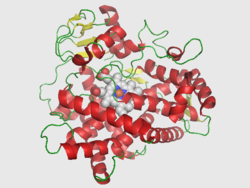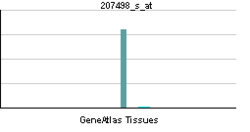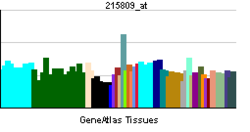- CYP2D6
-
Cytochrome P450 2D6 (CYP2D6), a member of the cytochrome P450 mixed-function oxidase system, is one of the most important enzymes involved in the metabolism of xenobiotics in the body. Also, many substances are bioactivated by CYP2D6 to form their active compounds. While CYP2D6 is involved in the oxidation of a wide range of substrates of all the CYPs, there is considerable variability in its expression in the liver. The gene is located near two cytochrome P450 pseudogenes on chromosome 22q13.1. Alternatively spliced transcript variants encoding different isoforms have been found for this gene.[1]
Contents
Genotype/phenotype variability
CYP2D6 shows the largest phenotypical variability among the CYPs, largely due to genetic polymorphism. The genotype accounts for normal, reduced, and non-existent CYP2D6 function in subjects.
The CYP2D6 function in any particular subject may be described as one of the following:
- poor metaboliser–these subjects have little or no CYP2D6 function
- intermediate metabolizers–these subjects metabolize drugs at a rate somewhere between the poor and extensive metabolizers
- extensive metaboliser–these subjects have normal CYP2D6 function
- ultrarapid metaboliser–these subjects have multiple copies of the CYP2D6 gene expressed, and therefore greater-than-normal CYP2D6 function
A patient's CYP2D6 phenotype is often clinically determined via the administration of debrisoquine (a selective CYP2D6 substrate) and subsequent plasma concentration assay of the debrisoquine metabolite (4-hydroxydebrisoquine). More recently, a "DNA microarray" has been developed, known as the AmpliChip, which allows the automated determination of a patient's CYP2D6 (and CYP2C19) genotype.
CYP2D6 activity was tested in "healthy infants receiving an oral dose (0.3 mg/kg) of dextromethorphan (DM) at 0.5, 1, 2, 4, 6, and 12 months of age. DM and its major metabolites were measured in urine. CYP2D6 genotype was determined by polymerase chain reaction-restriction fragment length polymorphism. Genotyping data indicated a strong correlation between CYP2D6 genotype and DM O-demethylation (beta=-0.638; 95% CI: -0.745, -0.532; P<0.001). CYP2D6 activity was detectable and concordant with genotype by 2 weeks of age, showed no relationship with gestational age, and did not change with post natal age up to 1 year. In contrast, DM N-demethylation developed significantly more slowly over the first year of life. Genotype and the temporal acquisition of drug biotransformation are critical determinants of a drug response in infants."[2]
Genetic basis of variability
The genetic basis for extensive and poor metaboliser variability is the CYP2D6 allele, located on chromosome 22. Subjects possessing certain allelic variants will show normal, decreased, or no CYP2D6 function, depending on the allele.
CYP2D6 allele and enzyme activity[3] Allele CYP2D6 activity CYP2D6*1 normal CYP2D6*2 increased CYP2D6*3 none CYP2D6*4 none CYP2D6*5 none CYP2D6*9 decreased CYP2D6*10 decreased CYP2D6*17 decreased Ethnic factors in variability
Ethnicity is a factor in the occurrence of CYP2D6 variability. The prevalence of CYP2D6 poor metabolizers is approximately 6–10% in white populations, but is lower in most other ethnic groups such as Asians (2%).[4] In blacks, the frequency of poor metabolizers is greater than for whites.[5] The occurrence of CYP2D6 ultrarapid metabolisers appears to be greater among Middle Eastern and North African populations.[6]
This variability is accounted for by the differences in the prevalence of various CYP2D6 alleles among the populations–approximately 10% of whites appear to have the non-functional CYP2D6*4 allele,[3] while approximately 50% of Asians possess the CYP2D6*10 allele,[3] which should produce decreased CYP2D6 function; however this still appears to be within the normal range and are still grouped as intermediate metabolisers.
CYP2D6 ligands
Following is a table of selected substrates, inducers and inhibitors of CYP2D6. Where classes of agents are listed, there may be exceptions within the class.
Inhibitors of CYP2D6 can be classified by their potency, such as:
- Strong inhibitor being one that causes at least a 5-fold increase in the plasma AUC values, or more than 80% decrease in clearance.[7]
- Moderate inhibitor being one that causes at least a 2-fold increase in the plasma AUC values, or 50-80% decrease in clearance.[7]
- Weak inhibitor being one that causes at least a 1.25-fold but less than 2-fold increase in the plasma AUC values, or 20-50% decrease in clearance.[7]
Selected inducers, inhibitors and substrates of CYP2D6 Substrates
↑ = bioactivation by CYP2D6Inhibitors Inducers - All[8] tricyclic antidepressants, e.g.
- Most[8] SSRIs (antidepressant), e.g.
- venlafaxine[8][7] (SNRI antidepressant)
- mianserin[8] (tetracyclic antidepressant)
- opioids
- antipsychotics, e.g.
- minaprine[7] (RIMA antidepressant)
- tamoxifen[8][7] ↑[10] (SERM)
- beta-blockers
- debrisoquine[7] (antihypertensive)
- Class I antiarrhythmics
- ondansetron[8][7] (antiemetic)
- donepezil[8][7] (acetylcholinesterase inhibitor)
- phenformin[8][7] (antidiabetic)
- tropisetron[8] (5-HT3 receptor antagonist)
- amphetamine[7] (in ADHD, narcolepsy)
- atomoxetine[7] (in ADHD)
- chlorphenamine[7] (antihistamine)
- dexfenfluramine[7] (serotoninergic anorectic)
- dextromethorphan[7] (antitussive)
- duloxetine[7] (SNRI)
- metoclopramide[7] (dopamine antagonist)
- Methoxyamphetamine[7]
- perhexiline[7] (antianginal agent)
- phenacetin[7] (analgesic)
- promethazine[7] (antihistamine antiemetic)
strong:
- SSRIs
- bupropion[7] (non-SSRI antidepressant)
- quinidine[7][8] (class I antiarrhythmic agent)
- cinacalcet[7] (calcimimetic)
- ritonavir[8] (antiretroviral)
Moderate
- sertraline[7] (SSRI)
- duloxetine[7] (SNRI
- terbinafine[7] (antifungal)
weak:
- buprenorphine[11] (in opioid addiction)
- amiodarone[7] (antiarrhythmic)
- cimetidine[7] (H2-receptor antagonist)
unspecified potency:
- antipsychotics
- hyperforin (St. Johns Wort)[13]
- antihistamines (H1-receptor antagonists)
- some SSRI antidepressants
- clemastine[7] (antihistamine and anticholinergic)
- celecoxib[7] (NSAID)
- clomipramine[7] (tricyclic antidepressant)
- cocaine[7] (stimulant)
- doxorubicin[7] (chemotherapeutic)
- metoclopramide[7] (antiemetic, prokinetic)
- methadone[7] (analgesic and anti-addictive)
- moclobemide[7] (antidepressant)
- ranitidine[7] (H2-receptor antagonist)
- doxepin[7] (tricyclic antidepressant, anxiolytic)
- halofantrine[7] (in malaria)
- levomepromazine[7] (antipsychotic)
- mibefradil[7] (calcium channel blocker)
- midodrine[7] (α1 agonist)
- ticlopidine[7] (antiplatelet)
- dexamethasone[7] (glucocorticoid)
- rifampicin[7] (bactericidal)
References
- ^ "Entrez Gene: CYP2D6 cytochrome P450, family 2, subfamily D, polypeptide 6". http://www.ncbi.nlm.nih.gov/sites/entrez?Db=gene&Cmd=ShowDetailView&TermToSearch=1565.
- ^ Blake, M.J. et al. (2007). "Ontogeny of dextromethorphan O- and N-demethylation in the first year of life.". Clin. Pharmacol. Ther.. April (4) (81): 510–516. doi:10.1038/sj.clpt.6100101. PMID 17301735.
- ^ a b c Droll K, Bruce-Mensah K, Otton SV, Gaedigk A, Sellers EM, Tyndale RF (1998). "Comparison of three CYP2D6 probe substrates and genotype in Ghanaians, Chinese and Caucasians". Pharmacogenetics 8 (4): 325–33. doi:10.1097/00008571-199808000-00006. PMID 9731719.
- ^ Australian Medicines Handbook (AMH) 2004. ISBN 0-9578521-4-2
- ^ Gaedigk A, Bradford LD, Marcucci KA, Leeder JS (2002). "Unique CYP2D6 activity distribution and genotype-phenotype discordance in black Americans". Clin. Pharmacol. Ther. 72 (1): 76–89. doi:10.1067/mcp.2002.125783. PMID 12152006.
- ^ McLellan RA, Oscarson M, Seidegård J, Evans DA, Ingelman-Sundberg M (1997). "Frequent occurrence of CYP2D6 gene duplication in Saudi Arabians". Pharmacogenetics 7 (3): 187–91. doi:10.1097/00008571-199706000-00003. PMID 9241658.
- ^ a b c d e f g h i j k l m n o p q r s t u v w x y z aa ab ac ad ae af ag ah ai aj ak al am an ao ap aq ar as at au av aw ax ay az ba bb bc bd be bf bg bh bi bj bk bl bm bn bo bp bq br bs bt bu bv bw bx by bz ca cb cc cd ce cf cg Flockhart DA (2007). "Drug Interactions: Cytochrome P450 Drug Interaction Table". Indiana University School of Medicine. http://medicine.iupui.edu/flockhart/table.htm. Retrieved on July 2011
- ^ a b c d e f g h i j k l m n o p q r s t u v w x y z aa ab ac ad ae FASS (drug formulary): Swedish environmental classification of pharmaceuticals Facts for prescribers (Fakta för förskrivare), retrieved July 2011
- ^ a b PHARMACOGENETICS AND PHARMACOGENOMICS. J. Steven Leeder PharmD, PhD Pediatric Clinics of North America - Volume 48, Issue 3 (June 2001). DOI: 10.1016/S0031-3955%2805%2970338-2.
- ^ Hoskins, J. M.; Carey, L. A.; McLeod, H. L. (2009). "CYP2D6 and tamoxifen: DNA matters in breast cancer". Nature Reviews Cancer 9 (8): 576. doi:10.1038/nrc2683. PMID 19629072.
- ^ Zhang W, Ramamoorthy Y, Tyndale RF, Sellers EM (June 2003). "Interaction of buprenorphine and its metabolite norbuprenorphine with cytochromes p450 in vitro". Drug Metab. Dispos. 31 (6): 768–72. doi:10.1124/dmd.31.6.768. PMID 12756210. http://dmd.aspetjournals.org/cgi/pmidlookup?view=long&pmid=12756210.
- ^ a b c d e FASS, The Swedish official drug catalog > Kodein Recip Last reviewed 2008-04-08
- ^ Foster, B.C. et al. (2004). "In Vitro Activity of St. John's Wort Against Cytochrome P450 Isozymes and P-Glycoprotein ". Pharmaceutical Biology. 42 (2) (2): 159–169. doi:10.1080/13880200490512034.
- ^ NIH-Inhibitory effects of H1-Antihistamines on CYP2D6
Further reading
- Smith G, Stubbins MJ, Harries LW, Wolf CR (1999). "Molecular genetics of the human cytochrome P450 monooxygenase superfamily". Xenobiotica 28 (12): 1129–65. doi:10.1080/004982598238868. PMID 9890157.
- Wolf CR, Smith G (1999). "Cytochrome P450 CYP2D6". IARC Sci. Publ. (148): 209–29. PMID 10493260.
- Ding X, Kaminsky LS (2003). "Human extrahepatic cytochromes P450: function in xenobiotic metabolism and tissue-selective chemical toxicity in the respiratory and gastrointestinal tracts". Annu. Rev. Pharmacol. Toxicol. 43 (1): 149–73. doi:10.1146/annurev.pharmtox.43.100901.140251. PMID 12171978.
- Lilienfeld S (2002). "Galantamine--a novel cholinergic drug with a unique dual mode of action for the treatment of patients with Alzheimer's disease". CNS drug reviews 8 (2): 159–76. doi:10.1111/j.1527-3458.2002.tb00221.x. PMID 12177686.
- Yu AM, Idle JR, Gonzalez FJ (2004). "Polymorphic cytochrome P450 2D6: humanized mouse model and endogenous substrates". Drug Metab. Rev. 36 (2): 243–77. doi:10.1081/DMR-120034000. PMID 15237854.
- Abraham JE, Maranian MJ, Driver KE, Platte R, Kalmyrzaev B, Baynes C, Luccarini C, Shah M, Ingle S, Greenberg D, Earl HM, Dunning AM, Pharoah PD, Caldas C (2010). "CYP2D6 gene variants: association with breast cancer specific survival in a cohort of breast cancer patients from the United Kingdom treated with adjuvant tamoxifen". Breast Cancer Res. 12 (4): R64. doi:10.1186/bcr2629. PMC 2949659. PMID 20731819. http://www.pubmedcentral.nih.gov/articlerender.fcgi?tool=pmcentrez&artid=2949659.
- Abraham JE, Maranian MJ, Driver KE, Platte R, Kalmyrzaev B, Baynes C, Luccarini C, Earl HM, Dunning AM, Pharoah PD, Caldas C (2011). "CYP2D6 gene variants and their association with breast cancer susceptibility". Cancer Epidemiol Biomarkers Prev. 20 (6): 1255–8. doi:10.1158/1055-9965.EPI-11-0321. PMID 21527579.
External links
PDB gallery Oxidoreductases: dioxygenases, including steroid hydroxylases (EC 1.14) 1.14.11: 2-oxoglutarate 1.14.13: NADH or NADPH Flavin-containing monooxygenase (FMO1, FMO2, FMO3, FMO4, FMO5) - Nitric oxide synthase (NOS1, NOS2, NOS3) - Cholesterol 7 alpha-hydroxylase - Methane monooxygenase - 3A4 - Lanosterol 14 alpha-demethylase1.14.14: reduced flavin or flavoprotein 1.14.15: reduced iron-sulfur protein 1.14.16: reduced pteridine (BH4 dependent) 1.14.17: reduced ascorbate 1.14.18-19: other 1.14.99 - miscellaneous B enzm: 1.1/2/3/4/5/6/7/8/10/11/13/14/15-18, 2.1/2/3/4/5/6/7/8, 2.7.10, 2.7.11-12, 3.1/2/3/4/5/6/7, 3.1.3.48, 3.4.21/22/23/24, 4.1/2/3/4/5/6, 5.1/2/3/4/99, 6.1-3/4/5-6 Cytochromes, oxygenases: cytochrome P450 (EC 1.14) CYP1 CYP2 CYP3 (CYP3A) CYP4 CYP5-20 CYP21-51 Categories:- Human proteins
- Cytochrome P450
- EC 1.14.14
Wikimedia Foundation. 2010.




